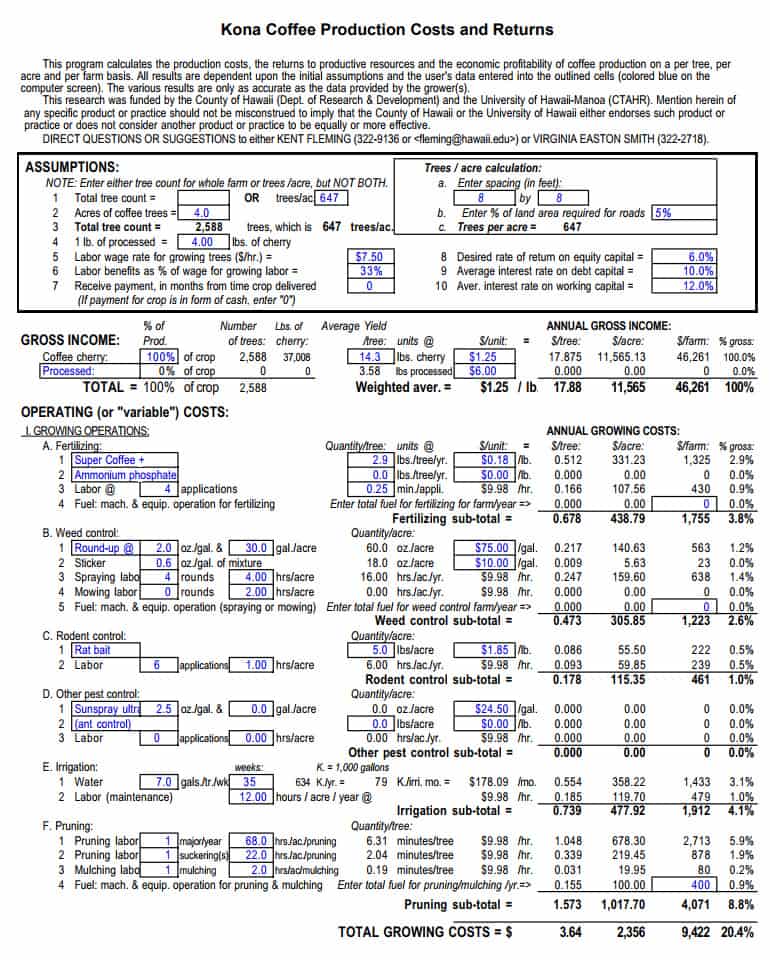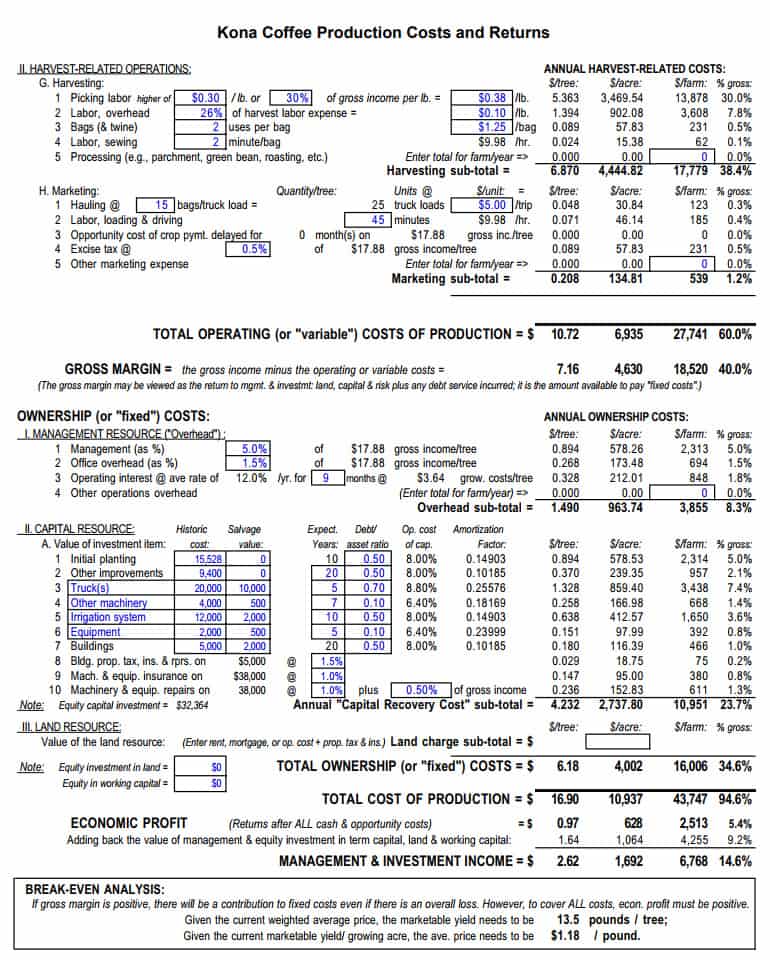Botanically classified as an evergreen shrub, the coffee plant is commonly called a tree or a bush, and is in the family Rubiaceae. Coffee plants are native to subtropical Africa and also southern Asia.
Coffee plants begin producing a full crop when they are about five years old and then continue to produce for the next fifteen to twenty years. One coffee plant may produce an average of about one pound of coffee beans each year.
Coffee Plants - A Botanical Description
Coffee trees (technically they are bushes) have glossy, dark green, ovate leaves (which last three to five years) and small, fragrant white flowers that bloom simultaneously in clusters - they bloom for just a few days over several months. In the Kona region these flowers are known as Kona Snow.
When is the Coffee Fruit Ripe?
The fruit of the coffee tree is known as the coffee cherry, and measures roughly ⅔-inch (1.5 cm) long, beginning as a green, unripe berry that gradually ripens to yellow, eventually turning an orange / crimson color before finally turning dark cherry-red / reddish-black (hence coffee "cherry"), at which time it is ready to be harvested for the prized coffee beans.
The growing process of the cherry takes about eight months, but can vary depending on climate (sunlight), soil (nutrients), other foliage (eg. shade-grown), varietal and altitude. The ripeness of a coffee cherry is determined primarily by color, but a more precise method involves gently squeezing a fruit to see if the seed (coffee bean) will come out easily. For most coffee trees, this happens right before the fruit is completely red (monochromatic) and can indicate that it's time to gather seasonal workers for harvesting.
Some coffee varietals have cherry (fruits) that remain yellow rather than red when ripened. There are a few processing methods known as "yellow honey process" and "red honey process" that have nothing to do with the cherry ripeness, but rather, how much fermenting takes place during processing.
While the beans inside the coffee fruit are typically what is prized, there's a growing market for the cherry itself either dried and made into Cascara (coffee cherry tea), or ground into a coffee flour.
Processing the Coffee Fruit
The center of the coffee cherry (fruit) is referred to as the bean or seed. After the cherry is harvested, the coffee bean is processed by either wet processing - the washed method, which includes pulping, milling, fermentation, and drying), or by dry processing (the natural method) which involves drying the coffee with the fruit still on the coffee beans.
Wet Processing of Coffee Cherry
Wet processing is a method of first removing parchment from the pulp from the coffee bean in the process called pulping, or de-pulping. This can be done mechanically, or on smaller farms, by a hand-mill. The mucilage is then removed through fermentation where the beans are dried, either in the sunlight or using mechanical dryers.
Dry Processing of Coffee Cherry
Dry processing involves drying the coffee cherry (fruit) in the sun for a period of time and then raking and turning the coffee cherry repeatedly until it is generally free of any dried fruit.
Each coffee processing method results in a different taste and aroma, but in both cases the end result is green coffee beans with a moisture content of about 10.5%. This moisture content is key to preventing mold during subsequent shipping to international brokers and importers.
Green Coffee Beans
After processing but before the green coffee beans are roasted they are known as referred to green coffee beans (or "unroasted coffee" in North America), though the natural color usually has a blue-ish hue to the green.
Peaberry Coffee Beans
Most coffee cherry (93-99%) encase two half-beans. When there is just one whole bean in the cherry it is known as peaberry.
Valued for their robust flavor, peaberry are the rarest type of coffee beans and have a higher density than non-peaberry coffee beans. Coffee brewed from peaberry is reputed to have a smooth consistency and rich aroma. This is said to be due to the single coffee getting all the nutrients of from the cherry and tree rather than sharing with a sibling. While roasters may prize it, we rarely find there's a noticeable difference.
Coffee Plant Varietals
The three main coffee plant varietals utilized to produce commercial coffee supplies are Arabica (Coffea arabica), Robusta (Coffea canephora var. robusta), and Liberica (Coffea liberica).
Virtually all of the world's gourmet coffees / premium gourmet coffees are produced from coffee beans from coffee plants that are varietals of Coffea arabica.
Coffee Plant Yields
The amount of coffee produced per tree, and number of trees per acre (or hectare) will determine the overall viability of a coffee farm. A report released by the University of Hawaii at Manoa uses estimates of approximately 650 trees/acre, 14-lbs of coffee per tree and 1-lb of green coffee per 4-lbs of cherries.

Coffee Farm Operating Costs

Coffee Farm Operating Costs - Analysis
Using these numbers as a benchmark is a good start for coffee farms, however yields will vary by year, varietal, etc. so more local figures should be used.
Naturally Decaf Coffee
A new strain of naturally caffeine-free coffee has come out of Cameroon (2008), named Coffea charrieriana after Professor A. Charrier, who managed coffee breeding and research at IRD for 30 years. Cameroon contains a variety of wild coffee trees, many of which have never been studied or catalogued. It will take a couple years for it to start appearing on the market and many more for commercial quantities to be available, but could represent a less process-intensive way of making decaf coffee.
[Stoffelen, P., M. Noirot, E. Couturon & F. Anthony. 2008. A new caffeine-free coffee from Cameroon. Botanical Journal of the Linnean Society 158: 67-72.]
Coffee From Soil to Sip
You can also learn about coffee harvesting and processing, coffee grading and roasting, coffee grinding and packaging, coffee storing, brewing, and all about the coffee beverage itself including Espresso.
Thank You! for visiting Espresso Coffee Guide
Espresso Coffee Guide - The Top Coffee Source
More great coffee information can be found in All About Coffee which covers all aspects of coffee from soil to sip.
This includes coffee plants and coffee cherry, and full descriptions of all of the world's top gourmet coffee beans including Organic Coffee, Fair Trade Coffee, Bird Friendly Coffee and Shade-Grown Coffee. Make sure to check out the Top 10 Coffees in the World.
Buy Gourmet Coffee Beans
- ✔️ Fresh roasted to order
- ✔️ 100% high qualtiy Arabica coffee
- ✔️ Custom grind (or whole bean)
- ✔️ 1-way valve, laminate bag (for freshness)
- ✔️ Bulk discounts



sadat ykubu
i need contacts of where to bye coffee in ghana....
terris
Thank you for this informative article about growing coffee plants. Is it practical to invest in coffee growing in Argao, Cebu? Where can i find information on this. I am a foreigner who is willing to invest here in this area of the Philippines, but only if I can get comprehensive information and advise. I would be most grateful for answers to these questions.
arnel malones
do you have a procedure on seedling preparation?and appropriate temperature requirements each varieties?
gerzel
Hello dear sir,
im luking for green Robusta coffe beans .
for i big quantity. for Georgian market.
good price the best prise.
thanks in ad vans
Moshiashvili
Barie Reid
What coffee variety would you recommend for West Mali? It is my intention to become a small scale farmer of fruit, veg and coffee; primarily for our own consumption, but will eventually expand as time passes.
Thank you
Barrie Reid.